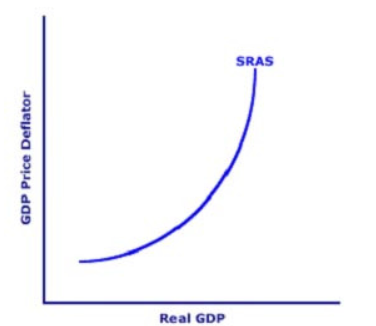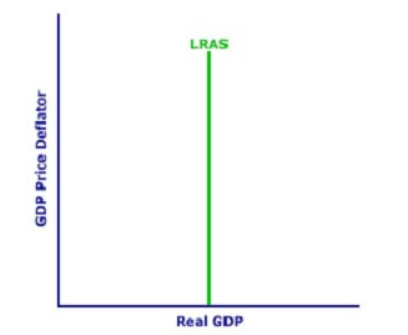Characteristics of Aggregate Supply
This section explains The Characteristics of Aggregate Supply (AS) covering, Introduction to Aggregate Supply (AS), The AS Curve, The Distinction Between Movement Along, and a Shift of, the AS Curve, The Relationship Between Short-Run AS and Long-Run AS and Long-Run Aggregate Supply (LRAS).
Introduction to Aggregate Supply (AS)
Aggregate Supply (AS) refers to the total quantity of goods and services that producers in an economy are willing and able to supply at various price levels, over a given period. It is an important concept in understanding the capacity of an economy to produce output and how that output changes in response to changes in the price level, resource availability, and economic conditions.
This revision guide explores the AS curve, the distinctions between movement along and a shift of the AS curve, and the relationship between short-run AS (SRAS) and long-run AS (LRAS).
The AS Curve
The aggregate supply curve shows the total output that firms are willing and able to produce in an economy at different price levels. It represents the relationship between the overall price level in the economy and the total quantity of goods and services supplied.
The Shape of the AS Curve
Short-Run Aggregate Supply (SRAS): In the short run, the aggregate supply curve is upward sloping. This is because, as the price level rises, firms are more willing to supply goods and services. The reason is that higher prices can lead to higher profit margins for firms, which incentivises them to increase production in the short term.

- Short-Run Flexibility: In the short run, some factors of production (such as labour or raw materials) are fixed, so firms can increase output by using existing resources more intensively. As the price level increases, firms can produce more to take advantage of higher prices.
Long-Run Aggregate Supply (LRAS): In the long run, the aggregate supply curve is vertical at the economy’s potential output or natural level of output. This reflects the idea that in the long run, the economy’s capacity to produce goods and services is determined by the availability of resources (such as labour, capital, and technology), not the price level.

- Long-Run Flexibility: Over time, firms can adjust all factors of production (including capital and labour) and technology. The economy will eventually produce at its full potential output, regardless of the price level, so there is no incentive to increase supply beyond this capacity.
The Distinction Between Movement Along, and a Shift of, the AS Curve
Movement Along the AS Curve
A movement along the AS curve occurs when there is a change in the price level, and as a result, firms change their level of output in response to the price change. This movement happens without any change in the factors of production (such as labour, capital, or technology).
- Short-Run Movements: In the short run, a rise in the price level leads to an increase in the quantity of goods and services supplied, resulting in a movement upwards along the SRAS curve. Conversely, a fall in the price level leads to a decrease in the quantity supplied, resulting in a movement downwards along the curve.
- Real-World Example: A rise in the price of oil can increase the cost of production for firms, reducing their supply in the short run (leading to a movement along the SRAS curve). Similarly, if the price of oil falls, firms may find it cheaper to produce, increasing their output.
Example: If the price level rises from P1 to P2, firms may increase their output from Q1 to Q2 because higher prices lead to higher profitability.
Shift of the AS Curve
A shift of the AS curve occurs when there is a change in the factors of production or any other conditions affecting aggregate supply, such as changes in resource availability, technology, or government policy. This leads to a shift in the entire curve, either to the left (decrease in aggregate supply) or to the right (increase in aggregate supply), independent of the price level.
Shift to the Right (Increase in Aggregate Supply): This occurs when there is an improvement in the economy’s productive capacity, such as:
- Improvements in technology.
- An increase in the availability or productivity of resources (e.g., labour or capital).
- A reduction in business costs (e.g., lower taxes, lower raw material costs, or deregulation).
- An increase in investment (e.g., increased business spending on capital).
Shift to the Left (Decrease in Aggregate Supply): This occurs when factors that increase production costs or reduce the availability of resources come into play. These factors include:
- A decrease in the availability of resources (e.g., labour shortages).
- Higher input prices (e.g., higher wages or raw material costs).
- Increased regulation or higher taxes that raise production costs.
- A decline in investment or capital stock.
Example: If the government reduces corporation tax, businesses may have more money to invest, increasing productivity. This would shift the SRAS curve to the right (increase in aggregate supply).
The Relationship Between Short-Run AS and Long-Run AS
Short-Run Aggregate Supply (SRAS)
The short-run aggregate supply curve (SRAS) shows the total quantity of goods and services that firms are willing to supply at different price levels in the short run, with some factors of production fixed (such as capital and land). The SRAS curve is upward sloping, indicating that as the price level rises, the quantity of goods and services supplied by firms increases.
- In the short run, firms may respond to higher prices by increasing production, especially when wages and other costs are sticky or slow to adjust. This allows firms to supply more goods and services as the price level rises, but only up to a certain point.
Key Features of SRAS:
- Firms have some flexibility to increase output due to higher prices.
- Factors of production may not be fully utilised, so the economy can produce beyond its current capacity in the short run.
- Price level affects output but does not influence the economy’s overall productive capacity in the short run.
Long-Run Aggregate Supply (LRAS)
The long-run aggregate supply curve (LRAS) is vertical, reflecting the idea that in the long run, output is determined by the economy’s potential capacity, which depends on the factors of production, such as labour, capital, and technology. In the long run, the economy cannot produce more than its full capacity regardless of the price level.
In the long run, any change in the price level will not affect the total quantity of goods and services that the economy can produce. Instead, the economy operates at its natural level of output (or potential output), which is determined by factors such as:
- The availability and quality of labour.
- The amount and quality of capital.
- Technological advancements.
Key Features of LRAS:
- The economy produces at its full potential output, regardless of the price level.
- Increases in factors of production (labour, capital, etc.) or technological improvements can shift the LRAS curve to the right, increasing the economy’s potential output.
The Relationship Between SRAS and LRAS
- In the short run, the economy may operate at a level of output that is above or below the full capacity of the economy, as the SRAS curve can shift in response to changes in aggregate demand or cost conditions.
- Over time, the economy adjusts, and in the long run, it moves towards its natural level of output, as determined by the LRAS curve. If there is an increase in aggregate demand in the short run, the economy might temporarily produce more than its potential output (leading to inflationary pressures). However, in the long run, firms will adjust their production capacity, and the economy will return to its potential output.
Summary of Key Points
- The SRAS curve is upward sloping, reflecting that in the short run, higher price levels incentivise firms to increase output.
- A movement along the AS curve occurs when there is a change in the price level, leading to a change in the quantity of goods and services supplied. A shift of the AS curve occurs when there is a change in factors affecting supply, such as resource availability or technological changes.
- The LRAS curve is vertical, representing the economy’s full capacity or potential output, which is determined by the availability of resources and technology in the long run.
- The economy can temporarily produce more or less than its potential output in the short run, but in the long run, it will return to the level of output determined by the LRAS curve.
By understanding the characteristics of the AS curve, the distinction between movements and shifts, and the relationship between SRAS and LRAS, you can analyse how aggregate supply affects the overall economy, including inflation, output, and employment.
